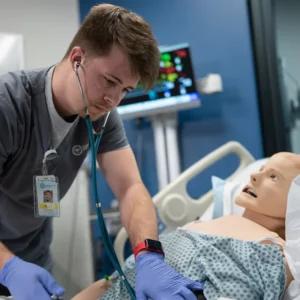 Although cancer is fairly common in pets, the disease is treatable. About half of all dogs and one-third of all cats ages 10 and older develop cancer.1 But as graduates of veterinary tech classes likely know, the disease doesn’t have to be life-restricting. Just like in humans, cancer is a class of diseases in which cells grow uncontrollably and attacks surrounding tissue. The disease can be localized (confined to one area) or generalized (spread throughout the body). The more body parts it reaches, the more dangerous it becomes. Unfortunately, since cancer is a “multifactorial” disease, which means it has no known single cause, it is hard to prevent.2 That’s why early detection and treatment are the best ways to manage the disease in pets.
Although cancer is fairly common in pets, the disease is treatable. About half of all dogs and one-third of all cats ages 10 and older develop cancer.1 But as graduates of veterinary tech classes likely know, the disease doesn’t have to be life-restricting. Just like in humans, cancer is a class of diseases in which cells grow uncontrollably and attacks surrounding tissue. The disease can be localized (confined to one area) or generalized (spread throughout the body). The more body parts it reaches, the more dangerous it becomes. Unfortunately, since cancer is a “multifactorial” disease, which means it has no known single cause, it is hard to prevent.2 That’s why early detection and treatment are the best ways to manage the disease in pets.
Common cancers
The common cancers found in dogs include malignant lymphona, which is a tumor of the lymph nodes, mast cell tumors, a form of skin cancer, and mammary gland tumors, also known as breast cancer. There is also a fair amount of bone cancer in dogs.¹ ³ Mary Lynn Higginbotham, assistant professor of oncology in Kansas State University’s College of Veterinary Medicine, said that while any dog can get cancer, certain breeds have a higher risk. “There are certainly some dog breeds that the Veterinary Health Center has noticed have a tendency to develop tumors, but it varies from tumor to tumor,” Higginbotham told Phys.org.1 “Osteosarcomas are the primary bone tumors we see in the limbs, most commonly in the front legs of large dog breeds like Great Danes, mastiffs, Labrador retrievers and rottweilers.” In addition, boxers, Boston terriers and golden retrievers are among the breeds that most frequently develop mast cell tumors. Although cancer is less common in cats than it is in dogs, it still affects a number of feline animals. Dave Ruslander, a veterinary oncologist and past president of the Veterinary Cancer Society, said one of the most common cancers in cats is lymphoma, which is associated with the feline leukemia virus.³ The good news is there’s a vaccine for feline leukemia. Another prevalent tumor is oral squamous carcinoma, similar to what humans develop.
Symptoms
Those graduating from veterinary technician programs should encourage pet owners to keep an eye on the following symptoms of cancer:1 2 4
- Growing lumps or bumps
- A wound that doesn’t heal
- Swelling
- Abnormal bleeding
- Abnormal discharge from any part of the body
- Chronic bad breath
- Persistent sores
- Rapid, unexplained weight loss
- Difficulty breathing, urinating or defecating
Diagnosis
To diagnose cancer, a veterinarian and certificated veterinary technician may perform X-rays, blood tests, ultrasonography and a physical examination. Ultimately, most cancers will require a biopsy, in which a piece of tissue is removed to confirm that the cancer is indeed malignant.
Treatment options
Many of the same treatment options for humans are applied to dogs and cats. Veterinarians will weigh the merits of surgery, chemotherapy, radiation therapy or immunotherapy. Still, the main difference lies in the dosage. “The majority of our drugs used for chemotherapy are the same drugs used in people, but we are very careful about the dose,” Higginbotham explained to Phys.org.1 “We use the amount of dose needed to maximize the response, yet limit the dose so we can diminish the potential for side effects as much as possible. Overall, less than 20 percent of our patients actually need supportive therapy because of a side effect from the treatment. The majority of animals we treat with chemotherapy or radiation therapy have very minimal side effects and those are usually short term.” It’s important to know that a pet’s risk of developing cancer increases with age. While cancer is the leading cause of death in dogs ages 10 and older, and is a problem area for cats, experts say half of all cancers in animals are curable if caught early.
1Elliott, L. (2014, December 3). Cancer prevalent in pets but treatable, says veterinarian. Retrieved December 3, 2014, from http://phys.org/news/2014-12-cancer-prevalent-pets-treatable-veterinarian.html
2Cancer. (2014, January 1). American Society for the Prevention of Cruelty to Animals. Retrieved December 3, 2014, from https://www.aspca.org/pet-care/dog-care/cancer
3Healthy Cats. (2009, April 29). Retrieved December 3, 2014, fromhttp://pets.webmd.com/cats/guide/cancer-in-cats-types-symptoms-prevention-and-treatment
4The National Canine Cancer Foundation dedicated to eliminating cancer in dogs. (2006,January 1). Retrieved December 3, 2014, from http://www.wearethecure.org/more_cancer_facts.htm



